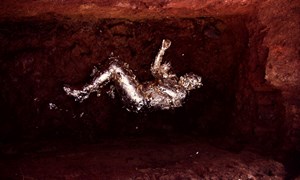
Johan Thom: "I am mainly interested in how the body, the world and the artwork are all brought together in a perfomative material relationship through which they all become singularly meaningful entities."
Johan Thom (b1976 Johannesburg) is an artist, artist/curator and academic based in Pretoria, South Africa. He is senior lecturer in Fine Art at the University of Pretoria and senior curator for Fried Contemporary Art gallery as well as head curator for Aardklop, The Potchefstroom National Arts Festival (2017- ongoing), South Africa. His works have been exhibited at The Venice Biennale (2003), The Canary Islands Biennale (2006), Iwalewahaus (2008), The Tate Modern (2015), Goodman Gallery South Africa (2015), The Johannesburg Art Gallery (2004, 2006), the Pretoria Art Museum (2018) and numerous other spaces. Thom holds a PhD In Fine Art from The Slade School of Fine Art, UCL, London on a Commonwealth Scholarship (2014).
ArtDependence Magazine: Do you have any thoughts on whether that’s a responsibility of artists, reflecting our time is important within the political context?
Johan Thom: What we term an artist today is someone who creates artworks (objects, videos, installations and so on) in some self-conscious relationship to their given context.
In that sense I do not think it is possible to make artworks without them being a direct result of external influences. Some artists may wish to highlight such influence(s) in their work while others may not.
I think artists must continue to work in different ways otherwise things quickly become one-dimensional and boring.
AD: What is your main interest as artist? What form of self-consciousness is applicable to the art-making?
JT: I am mainly interested in how the body, the world and the artwork are all brought together in a perfomative material relationship through which they all become singularly meaningful entities. On an easy level this explains my interest in performance art. In performances In performances and video installations such as ‘Theory of Flight’ (2006), ’Figurehead’ (2010) and ‘Challenging Mud’ (2008) I utilise raw materials such as honey, oil, soil and gold and even animals along with my body to set up a dynamic sensory and conceptual relationship with the audience. With more complexity, this focus on the perfomative drives my expanded interest in making sculpture from volatile unstable materials and other processes that I am not completely in control of.
I made a whole series of sculptural artworks recently from polyurethane foam that rapidly expands and oozes as you cast it. For example, I made a huge ecological disaster at the Nirox Foundation last year in South Africa using weeds, glass, wood, bronze and polyurethane foam. This was as much a comment on that environment, a virtual utopian garden, as it was on the changing status of public sculpture and art in South Africa at the time.
In another example I simply cast my body weight in molten copper out on the floor as a self-portrait. Of course copper is oligodynamic material, meaning that it is ani-bacterial. In a kind of reversal of the Portrait of Dorian Gray, this self-portrait will never get sick, age and die whereas I of course will.
AD: Do you feel that it’s important to convey your own beliefs and opinions within your art? Is there a philosophical element in your work?
JT: Art is an embodied form of philosophy and theory. For me it is the purest reflection of who I am, what I think, how I live and what I believe in.
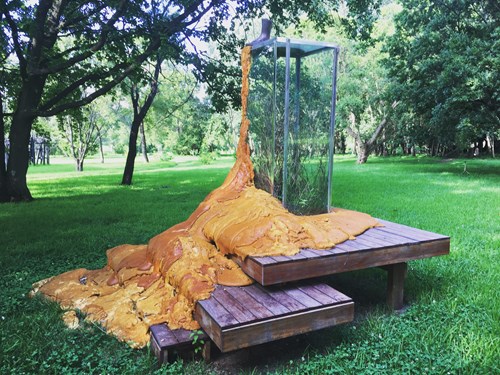
Hanging Garden, 2016, Johan Thom
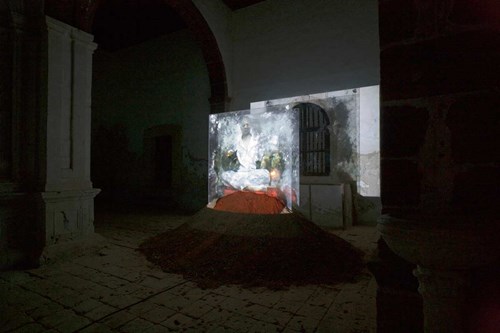
Theory of Flight, 2006, Johan Thom
AD: What are you currently working on? Is there anything in particular that you’d like to get across through your work?
JT: At present I am thinking!
I promise I am not making a joke. When I was studying for my PhD at the Slade in London I learned again what the real value of thinking was: one cannot simply keep making without thinking. My next series of works will all be a deeply personal reflection on recent events in my life. The problem is to make the work in such a way that it resonate with an audience that may not know all the details involved.
AD: What place does creativity have in education ? Do you view yourself as a creator?
JT: Education without creativity is the end of our species. Nature is incredibly creative and given that we are part of it, our actions and thoughts must continue along that path. Many art schools and educational institutions are attempting to standardise everything these days but I think there must be a balance between pragmatic problems and creative vision. Without it we are doomed to become a bunch of bureaucrats only. This is as true for scientists as it is for the humanities.
I am an artist, not a creator. An artist is a sophisticated thief and a poet of the world.
AD: Do you think that by challenging conventional views, art can truly make a change in the public’s perception?
JT: I am not so certain about that anymore, the public is too big a thing to account for. But if you change one person’s opinion you have accomplished much. What art can do is to improve the quality of our lives by allowing us to think about meaning without imposing set limits.
I sometimes make very political work and my hope is that people will take the challenge seriously. But mostly I make the work for myself, because I realise that I have to. At the height of the student uprisings in South Africa, I made a highly political work using a cast portrait of Faust, a protest sign and a crucifix. I made the work because I needed to speak about the experience and the issues at stake in a carefully considered, complex way.
AD: How has your work developed since you began and how do you see it evolving in the future?
JT: What I am always thankful for is that early on no one forced me to clearly define my artistic project and so I simply tried everything. I was allowed to fail and to learn, even publicly. But my work was always non-commercial, so dealers pretty much left me alone.
In that sense my development as an artist has been organic, a slow pleasant uncovering of what I am really interested in as a person, as opposed to peer pressure to present easy spectacles for mass consumption and quick public dissemination.
AD: Is sophistication, aesthetic accomplishment in the eye of the beholder?
JT: Certainly it is too. One has to learn to look carefully, to see things.
Let me use an example. Radiologists can see things in highly detailled scans of the human body that no ordinary person can see, even though for a trained radiologist the information is somehow self-evident. Knowledge and practice makes all the difference.
Of course if artists make dull work there wont be much to see and think about. A radiologist cannot see much in a poor scan! In that sense artworks may be understood as some kind of technology of seeing that is located in a historic context and through which we come to look at ourselves.
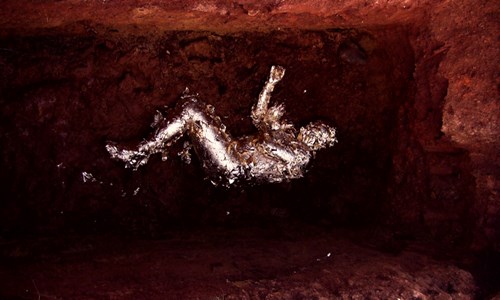
Challenging Mud, 2008, Johan Thom
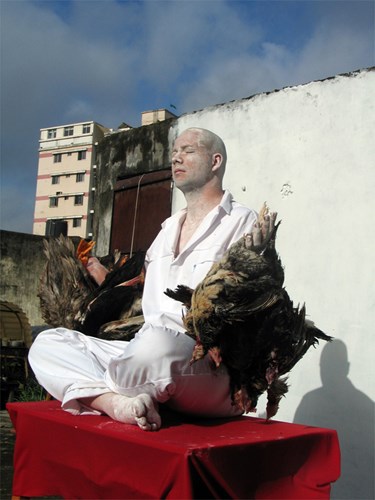
Theory of Flight2, 2006, Johan Thom
AD: What do you think is the social role of art? How would you like to be remembered?
JT: Art is mirror. I would like to be remembered as an artist that made the scratches and messy blotches on the surface of the mirror shine shine bright.
AD: How does art school form ideas about art? Does it shape people into being certain types of artists?
JT: Art schools are powerful spaces inasmuch as they help shape the works of young artists. My honest opinion is that one should attend a few different art schools in different places in the world and learn to know what actually interests you - and not simply what is hot or cool at any given point in time at a particular school.
AD: What do you think about the art world and art market? Do you accept that art is inherently an elitist activity?
JT: I think the art market is too powerful today. I feel sorry for young artists that will not experience the freedom to make without being so involved in its commodity logic. The many artists I admire all make art because the feel they have too. They make work in smaller communities and smaller galleries and view it as part of a greater social experiment and changing context. Artists must work for smaller and more loyal constituencies, thus in some way counteracting its elitist bias by ignoring the glitz and glam of fame and fortune.
Today the commercial art market is the primary context where art functions. Even the Biennales pale in comparison to the great experiment that is the contemporary global commercial art fair circuit. But there is no use in being nostalgic. The best young artists will still challenge the system and help shape another future - one with its own rewards and problems. And in time they will be remembered for it.
AD: What’s the last great book you read? Any other thoughts/projects to share?
JT: Today I almost only read biographies or science books. Those are the things I know least about. But I recently read ‘Quarantanni 1973-2013’ by the great Italian gallerist Massimo Minini. It is a collection of personal letters between him and the artists he has worked with through the years as well as images of past exhibitions and so forth. It is wonderful to read how much fun and how deeply rewarding art can be if people do it because they love it and care about making and exhibiting the best artworks possible.
Currently I am working on a curatorial project named ‘Ghosts Thieves and Poets’ for Aardklop, The Potchefstroom National Arts Festival in South Africa due to be held 2-7 October 2018. I am truly excited to be able to bring an artists vision to the festival as head curator and to include some of the artists work that I most admire and enjoy in the world such as Marina Abramović, Diane Victor, Roger Ballen, Raimi Gbadamosi, Olu Oguibe and numerous others.

ArtDependence Magazine is an international magazine covering all spheres of contemporary art, as well as modern and classical art.
ArtDependence features the latest art news, highlighting interviews with today’s most influential artists, galleries, curators, collectors, fair directors and individuals at the axis of the arts.
The magazine also covers series of articles and reviews on critical art events, new publications and other foremost happenings in the art world.
If you would like to submit events or editorial content to ArtDependence Magazine, please feel free to reach the magazine via the contact page.